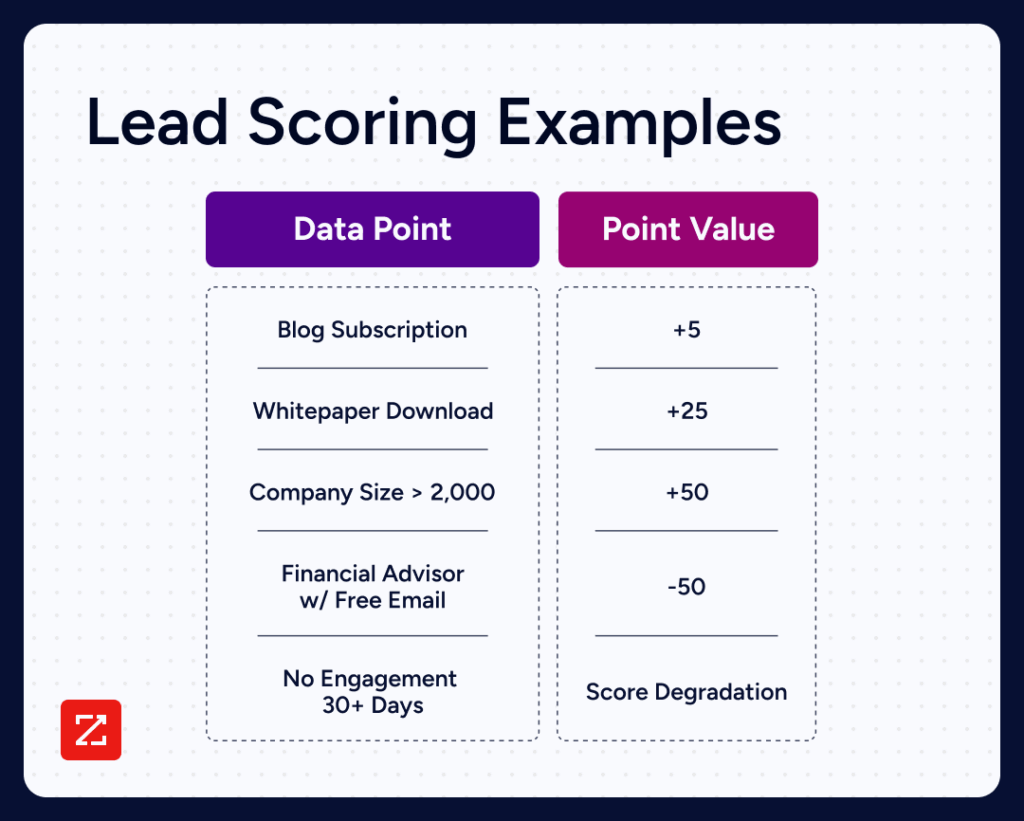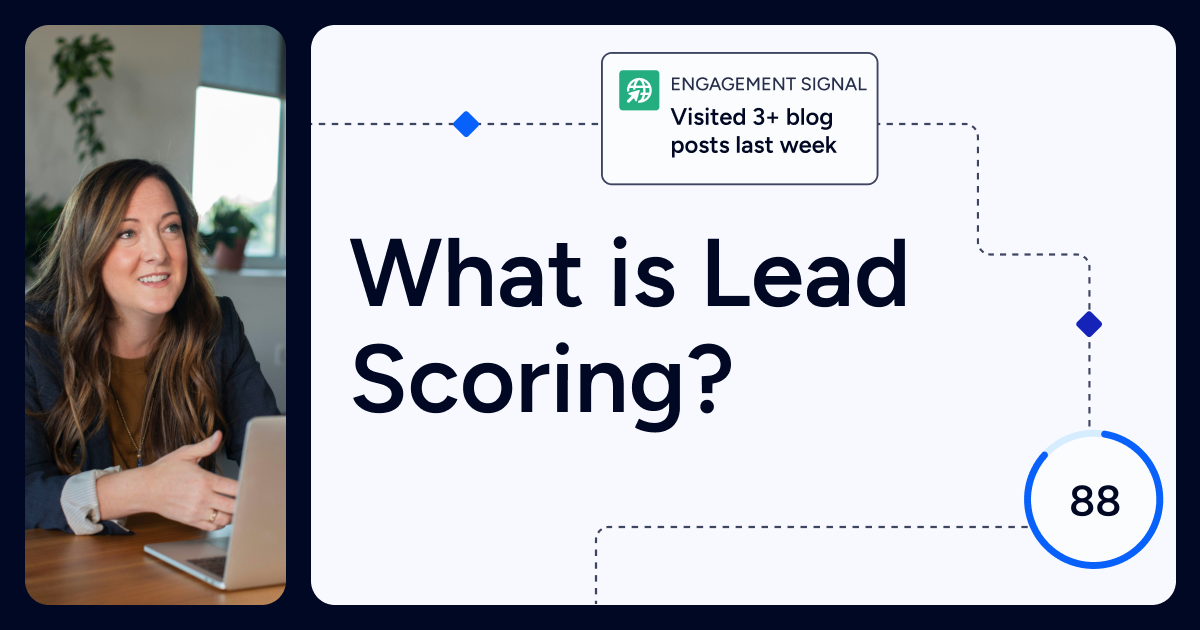Most marketers operate under one primary directive: to generate leads for their business. But not all leads convert into paying customers, which raises a few questions:
How do you determine which leads are most likely to become buyers?
How can you optimize campaigns to generate better leads?
The answer is lead scoring: a process for ranking the sales-readiness of a lead to understand which leads are most likely to convert into paying customers.
What is Lead Scoring?
Lead scoring is a systematic approach to evaluating and ranking potential customers based on their likelihood of making a purchase. This process helps marketing and sales teams prioritize their efforts effectively. It works by:
Determining which criteria or data points indicate a sales-qualified lead
Assigning point values to each criterion
Finalizing a score for each lead, shaping how sales handles them
A lead scoring system allows you to reduce subjectivity in the process and understand which leads have the best chance of converting. Lead scoring systems can be done in a number of ways, from relatively manual (think spreadsheets) to much more advanced, automated scoring systems.
Among the most advanced are predictive lead scoring systems, which use machine learning (ML) — a subset of artificial intelligence (AI) — to build algorithms that automatically analyze data from customers and prospects.
Using this information, predictive lead scoring programs forecast the quality and likelihood of winning business from a lead, and assigns them a corresponding score.
Salesforce’s Pardot is an example of marketing automation software that uses predictive lead scoring to keep up with all leads. Backed by technology with the ability to “learn,” predictive lead scoring makes the lead scoring process faster and more accurate.
Why Score Your Leads?
Lead scoring is much more than just a marketing strategy. It can make your entire business more effective and align many teams in your company. If implemented correctly, lead scoring can have the following positive effects:
Academic research shows that companies using lead scoring can see an astonishing 70% improvement in ROI of lead generation efforts compared to companies who don’t.
By focusing on high-quality leads, lead scoring helps teams allocate resources more efficiently, reduce wasted effort on unqualified prospects, and accelerate the sales cycle. This leads to not only improved conversion rates but also a stronger collaborative environment between sales and marketing, fostering shared goals and accountability.

How to Build a Lead Scoring Model
Now that you understand what lead scoring is and why it’s important, it’s time to learn how to build a model for your business. Lead scoring models typically combine implicit data (inferred from a customer’s online behavior, such as website activity, email engagement, or content downloads) and explicit data (information customers directly provide, such as name, company, job title, or location) to create a comprehensive picture of a prospect.
No matter which method you use, there are five key steps to building a successful lead scoring model:
1. Create Buyer Personas
Before you can score your leads, you must have a clear understanding of the characteristics that make a prospect an ideal fit for your products and services. That’s where buyer personas come in. A buyer persona is a semi-fictional representation of your ideal customer. Each buyer persona profile is made up of criteria gleaned from quantitative research, anecdotal observations, and existing customer data. Defining your buyer personas is also crucial for setting your Ideal Customer Profile (ICP), ensuring you target the most valuable accounts.
2. Determine Which Data Points to Score
Now that you know what your ideal buyers look like, it’s time to decide which attributes you will assign a point value to. Lead scoring criteria can be broken up into two main categories—demographic information and behavioral information.
3. Assign Point Values
Not all scoring criteria are created equal. Remember: your goal is to define which traits and actions eventually lead to a closed deal. So, you need to assign numerical values to each data point accordingly. For example, leads who subscribe to receive blog updates don’t often convert to paying customers. Conversely, leads who download a whitepaper tend to have a very high conversion rate. So, blog subscribers get scored two points while those who download white papers get 25 points.
4. Determine the Point Threshold That Makes a Lead Sales Qualified
Once you assign each data point a score, you total all points amassed by a single lead and that’s their final lead score. Simple, right? Not so fast. The tricky part is this: You must determine what range of scores represent “sales-readiness”. This will likely require some testing and analysis when you first implement lead scoring.
This is also a great opportunity to align sales and marketing on how they will approach processes for leads of certain scores. For example, if, after careful analysis, you find most leads that have a score below 30 never turn into customers, you can come up with an agreement. Sales will follow up with all leads with a score of 30 or higher. Those who fall below that threshold will be placed into a lead nurture program until they’re ready to buy.
5. Use Sales and Marketing Automation Tools
If you think lead scoring sounds great, but nearly impossible to get right manually — you’re right.
Scoring leads well, especially if you have thousands of them, is extremely time-consuming. Add to that the fact that lead scores change as leads are nurtured through the sales funnel and you’ve got a recipe for poor productivity, data inaccuracies, and big lead-routing issues.
Marketing automation takes over mundane, repetitive marketing processes and eliminates the need for human intervention. You’ll often see it applied to marketing and sales workflows, like triggering campaigns, personalizing ads, and, of course, prioritizing leads.
Most marketing automation tools have lead scoring software built in that handles lead scoring for you. All you have to do is enter your scoring criteria, and it will score leads as they come in and update their scores as they change. For example, ZoomInfo Marketing automates manual activities and assists throughout the lead scoring and management process, including:
Automatically creating and feeding your CRM, campaigns, and routing workflows important data segment information
Creating multiple, highly customized scoring models
Identifying the most high-priority leads via data-powered account scoring
By implementing these strategies, your business can transform its lead generation efforts into a precise, efficient, and revenue-driving engine. Start leveraging data and automation to pinpoint your most promising leads and accelerate your growth today.


